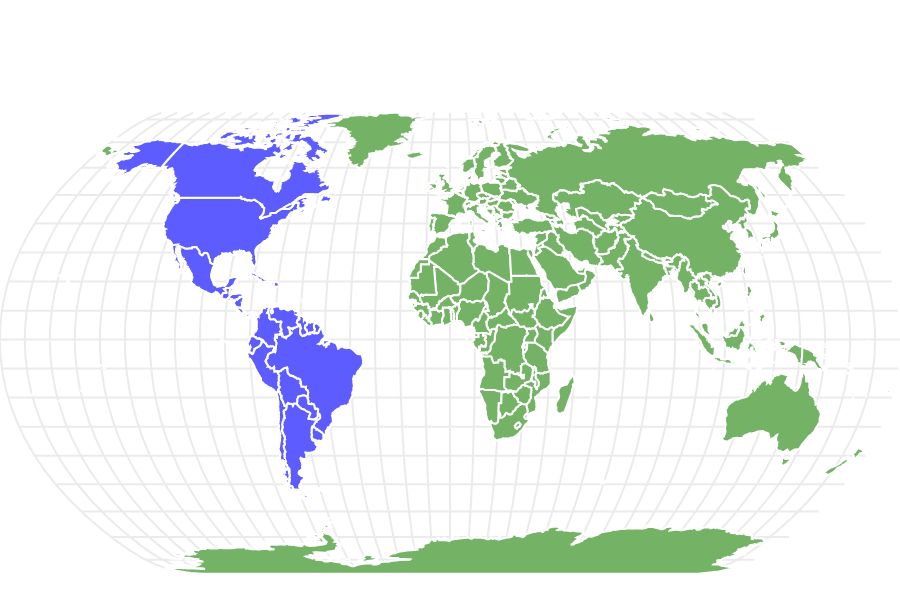Saber-Toothed Tiger
Smilodon populator
Canines up to 7 inches long!
Advertisement
Saber-Toothed Tiger Scientific Classification
- Kingdom
- Animalia
- Phylum
- Chordata
- Class
- Mammalia
- Order
- Carnivora
- Family
- Felidae
- Genus
- Smilodon
- Scientific Name
- Smilodon populator
Read our Complete Guide to Classification of Animals.
Saber-Toothed Tiger Conservation Status
Saber-Toothed Tiger Facts
- Main Prey
- Deer, Bison, Woolly Mammoth
- Distinctive Feature
- Large muscular body and long canine teeth
- Habitat
- Forests and grasslands
- Predators
- Humans
- Diet
- Carnivore
View all of the Saber-Toothed Tiger images!
“The most prominent feature of the saber-toothed tiger was its long, sharp, canine teeth. It would hide in the grass, lie in wait, and then pounce on its prey to deliver a fatal bite.”
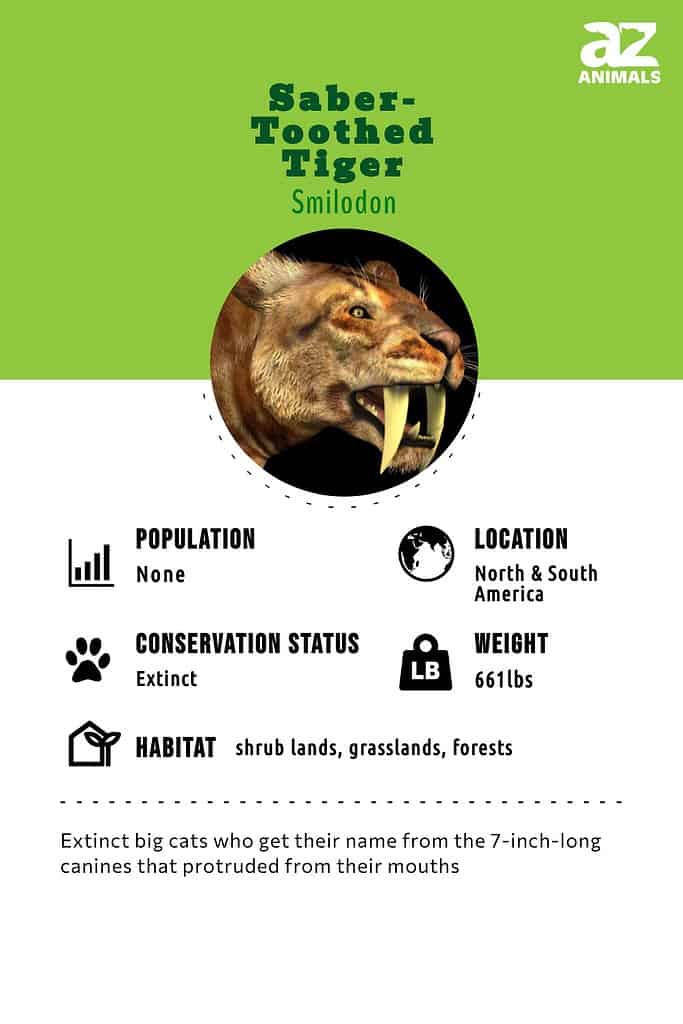
The saber-toothed tiger roamed freely in the Americas from around 2.5 million years ago until the species went extinct around 11,700 years ago. It was an apex predator and killed large animals by hunting in packs. Even an American Mastodon that stood over 10 feet (3 meters) tall and weighed up to 12 tons (5,455 kg.) was not safe from this predator.
Its only true enemy was human beings. Human hunters and temperature changes are thought to have driven this animal to extinction.
Amazing Saber-Toothed Tiger Facts!
- The canine teeth of the saber-toothed tiger averaged 14 cm. (7 in.). They could reach up to 28 cm. (11 in.) long for the largest of S. populator species.
- Thousands of fossils of saber-toothed tigers were found in the La Brea Tar Pits located in Los Angeles. They got stuck in the tar trying to prey on the other animals that were stuck. It is the second most commonly found fossil at that location. This creature may have enjoyed a nice last meal before succumbing to death by slowly sinking into the tar.
- The largest of the species could weigh up to 400 kg. (882 lb.). They could be almost 100 cm. (39.4 in.) tall when standing on four legs and much taller 175 cm. (68.9 in.) when rising up to pounce on prey.
- This animal is very different from a modern-day tiger or a cat. No direct descendant exists today.
- Scientists determined from the fossilized bones of its vocal cords that the saber-toothed tiger could roar like a modern-day lion and probably much louder.
Scientific Name
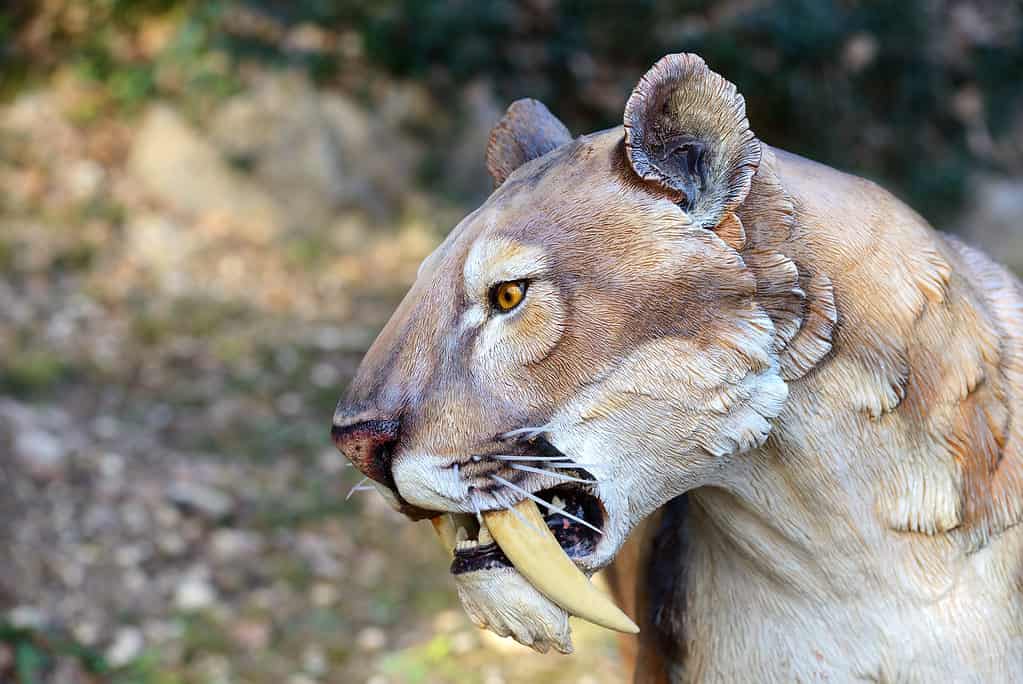
Smilodon is the scientific name for saber-toothed tigers.
©Sfocato/Shutterstock.com
The scientific name for the saber-toothed tiger is Smilodon. There are three species in the Smilodon genus. Smilodon gracalis is thought to have evolved from the Meganterreon. The Meganterreon was a saber-toothed cat that lived in Africa, Eurasia, and North America. Smilodon populator and Smilodon fatalis are likely to have descended from the smaller Smilodon gracilis.
The root definition of the name Smilodon means a two-edged knife combined with a tooth. This predatory mammal was named for its prominent canine teeth. The most well-known Smilodon is Smilodon fatalis, which most people call the saber-toothed tiger.
Here is the scientific classification hierarchy of the Smilodon:
- Domain: Eukaryota
- Kingdom: Animalia
- Phylum: Chordata
- Class: Mammalia
- Order: Carnivora
- Family: Felidae
- Subfamily: Machairodontinae
- Tribe: Smilodontini
- Genus: Smilodon
Types of Saber-Toothed Tigers
Scientists currently recognize three distinct species of Smilodon:
- Smilodon populator
- Smilodon gracilis
- Smilodon fatalis
Evolution
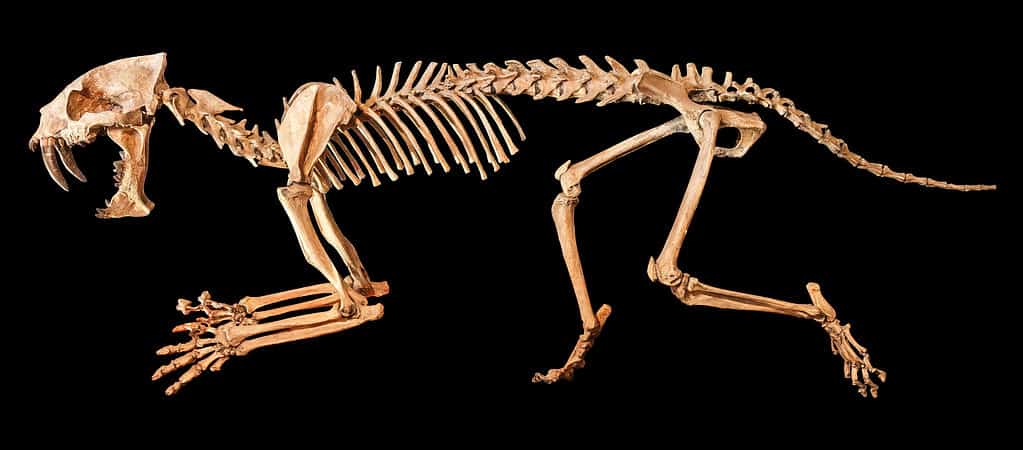
Skeletal remains of the saber-toothed tiger are rare in the archeology world.
©Puwadol Jaturawutthichai/Shutterstock.com
Smilodon is distinct from other saber-toothed cats like the Homotherium because they lived in the Americas and also displayed much larger, more distinct features. Complete fossils of the smilodon are incredibly rare and oftentimes disputed when they do emerge. Because of this, the anatomy and appearance of the saber-toothed tiger are largely unknown, and depictions rely on the help of the artist’s imagination in order to fill in the gaps that science has not yet discovered. What is known about the smilodon is that it first evolved into a unique species during the late Pleistocene from a branch of the Felidae family tree incredibly distant from modern cats. Geneticists have also been able to use DNA from the smilodon’s teeth to gather a picture of what these fierce predators once ate.
Appearance
The fossil record preserved only the bones, making the true appearance of this animal uncertain. It is likely that a saber-toothed tiger would have the coloration that allowed it to camouflage itself in the tall grass when waiting for prey. This means it could be brown, tan, white, yellow, or even black if it hunted at night. It might have been spotted to help with the camouflage.
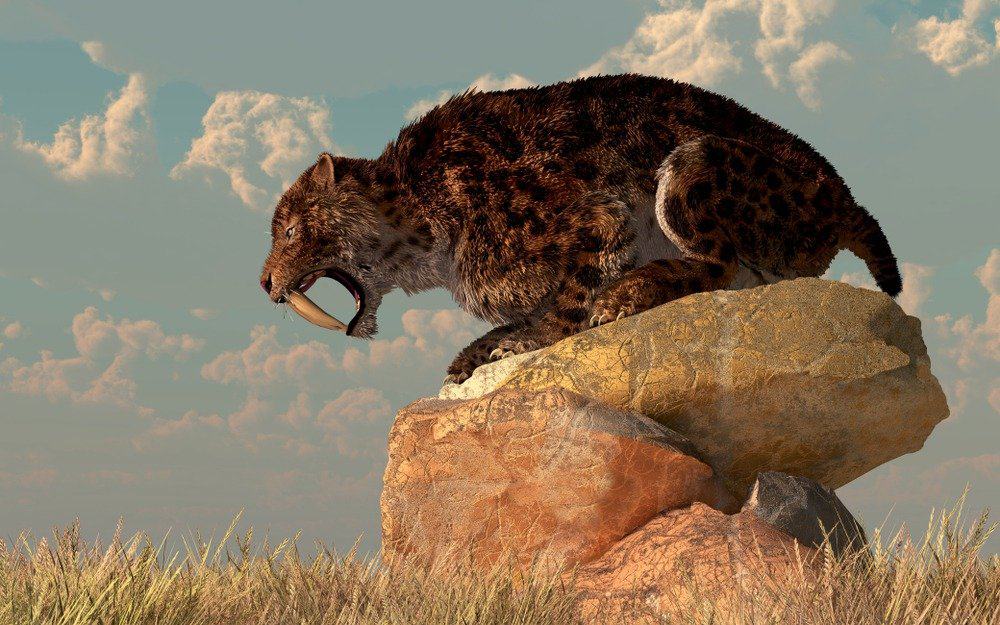
Nobody knows for sure what the saber-toothed tiger looked like aside from its menacing mouth.
©Daniel Eskridge/Shutterstock.com
Behavior
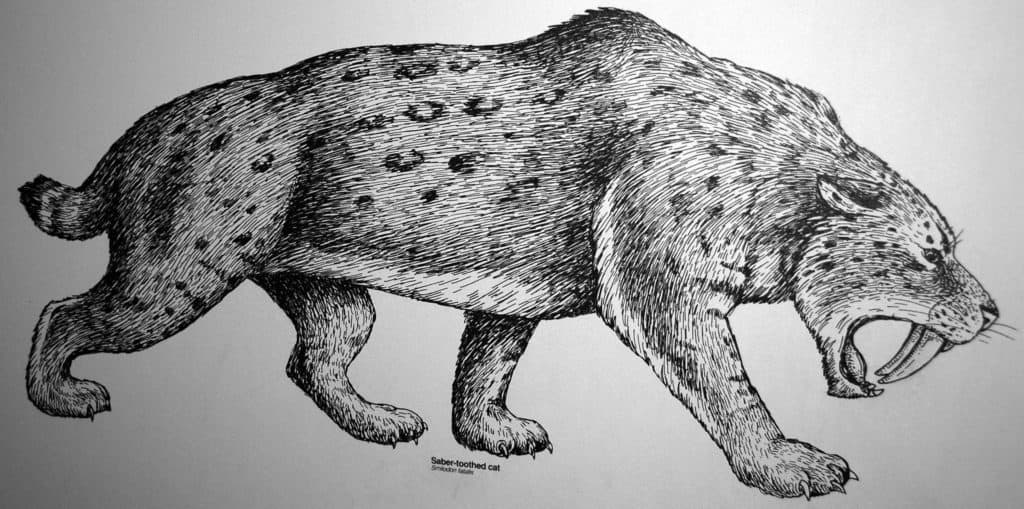
Saber-toothed tigers had no trouble finding meals.
©James St. John / CC BY 2.0, Flickr – License
The hunting strategy of this animal is probably like modern lions. It is theorized that they hunted in a pack with its pride. They likely wandered around to find an area with good prospects for a meal and then hunched down to stay perfectly still and wait for their prey to get close enough to pounce. This is predatory hunting by ambush style.
Research on the dental markings on the teeth of the saber-toothed tiger suggests that they did not eat many bones, so it is likely there was plenty of food supply available for easy-to-kill animals. Their attack method was to bite their prey with a deep gash in a vital area and then wait for the prey to bleed out.
The scientists concluded this because the large teeth could be easily broken if used to grab and hold. This creature could use its front claws and forearms to wrestle an animal down and then bite its neck to rip open its throat. Most of the saber-toothed tiger fossils found have their teeth intact so this led to the conclusion of using a fatal bite as the hunting method.
Their prey would be surprised by the attack and, with one or more bites from the group attack, be mortally wounded. These animals would then follow the prey as it tried to escape while bleeding profusely. When the animal lost enough blood it would collapse and die. Then, it was time for a meal. All the pride would eat together and a kill would be shared to feed the older ones, those too young to hunt, and those who were lame or sick.
The fossils show that many smilodons lived long, healthy lives. Some recovered from injuries that would have prevented hunting, like broken bones. This meant another saber-toothed tiger helped them to get food during advanced age or recovery from an injury. They were vicious killers; nevertheless, they took good care of their own.
Habitat
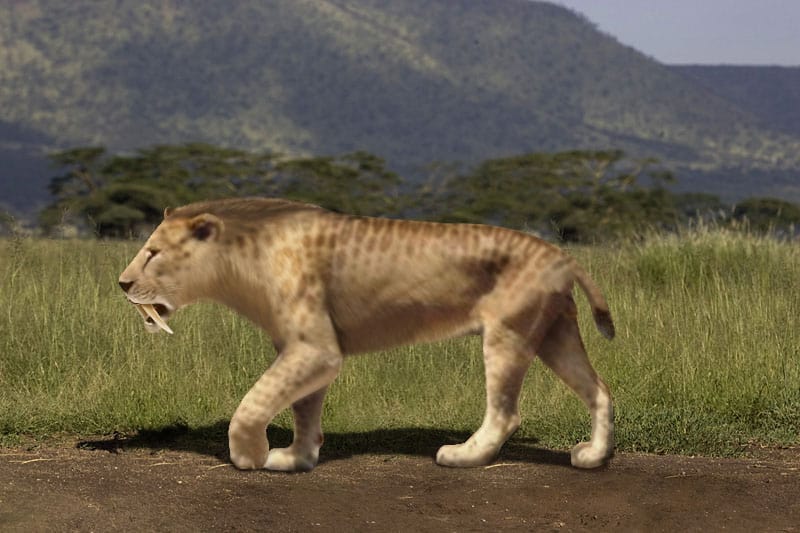
Saber-toothed tigers once inhabited North and South America.
©Rom-diz, CC BY-SA 3.0, via Wikimedia Commons – License
This creature lived in the areas where its prey lived. This included all the areas that plant-eating animals liked such as forests, shrubby areas, and grasslands. It must have employed the strategy of hiding near a watering spot to catch its prey unawares when the prey came up for a drink.
The habitat range was very wide. It includes all of the Americas from east to west and north to south. As this creature spread to South America from North America, its size increased creating the new species of S. populator as a descendant from the much smaller S. gracilis.
The saber-toothed tiger lived through the Ice Age and was accustomed to very cold weather. At the end of the Ice Age, when the temperature increase dramatically, it is thought that within a very short time, may even only about 100 years or so, the saber-toothed tiger went extinct after being on earth for 2.5 million years.
The impact of climate change on its ability to survive was very dramatic. They still had plenty of food but the food sources changed, when all the megafauna (large animals) disappeared.
Climate change affected the animals and also brought human migration. This double impact of temperature change that disrupted the habitat and the invasion of humans was what combined to make this animal go extinct.
Diet
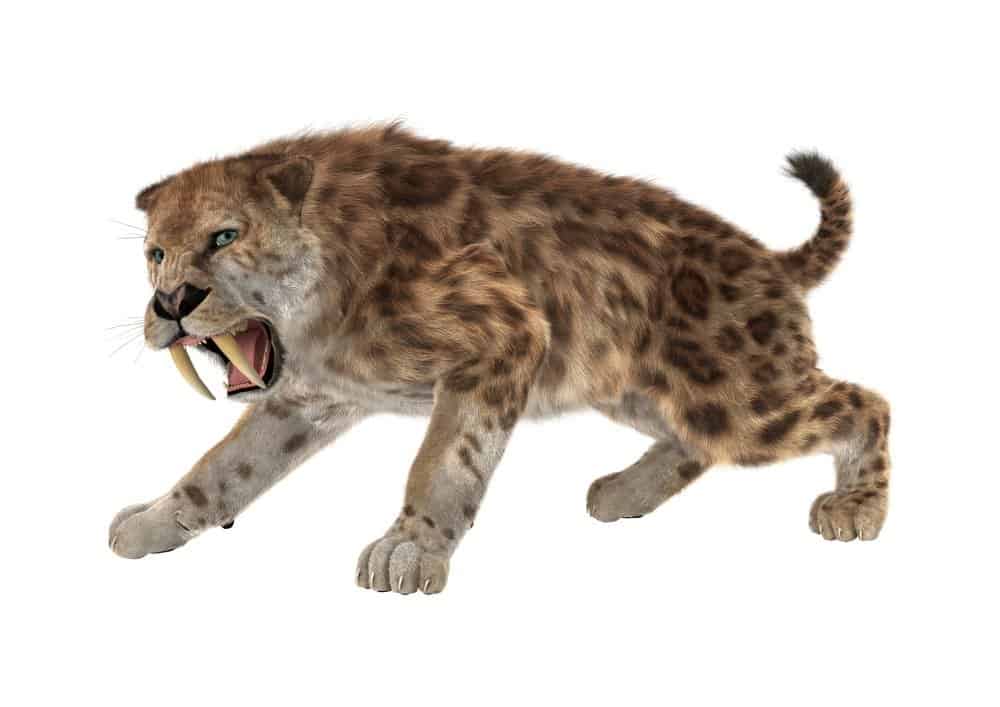
Smilodons were both predators and scavengers.
©Valentyna Chukhlyebova/Shutterstock.com
Studies of the fossil records of the saber-toothed tigers’ teeth indicate that they mostly ate large animals with thick skin and muscles, and then left the bones behind for some other scavenger. If they had eaten a lot of bones, this causes an identifiable wear pattern on the teeth, which the fossils of saber-toothed tigers do not have.
The saber-toothed tiger was a very capable hunter and took down many creatures on its own, such as bison, camels, horses, woolly mammoths, mastodons (now-extinct, huge, hairy elephants), and giant sloths. It has also been theorized that smilodons could have also exhibited scavenger-like behavior, stealing antelope, capybara, caribou, elk, oxen, peccaries, tapir, and other smaller- to medium-sized animals from other predators who had already hunted and killed them.
Predators and Threats
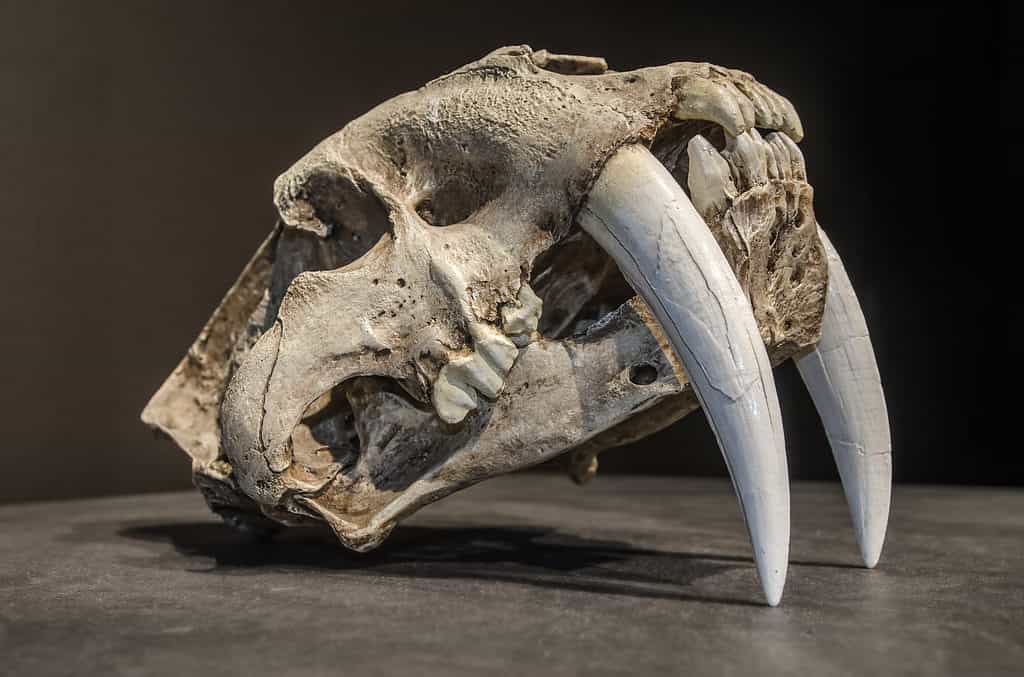
Saber-toothed tigers were apex predators and had no natural threats before humans.
©Sasha Samardzija/Shutterstock.com
The only predators that hunted the saber-toothed tiger were humans. Many scientists believe that humans hunted the saber-toothed tiger to extinction. Dramatic human expansion into the Americas occurred at the time of the saber-toothed tigers’ death. Temperature rise from the climate changes at the end of the Ice Age may have also played a part in causing the saber-toothed tiger to go extinct.
Reproduction, Babies, and Lifespan
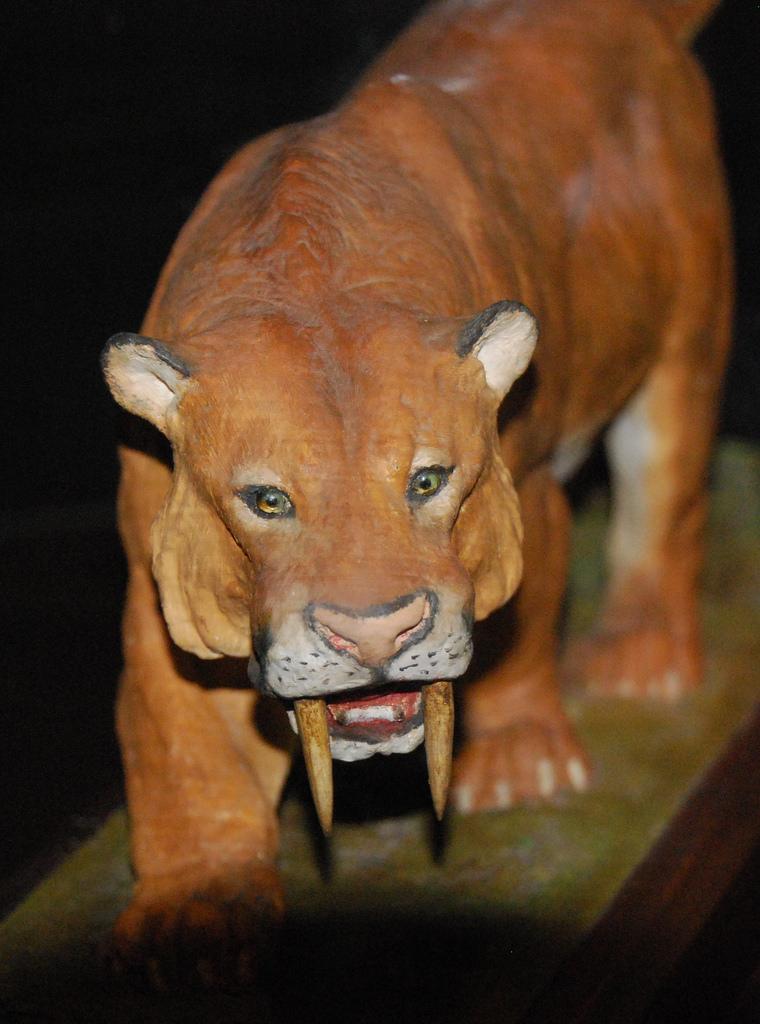
Smilodon could live an estimated 40 years in the wild.
It is likely, but not known, that saber-toothed tigers were seasonally polyestrous. This means the female could go into heat more than once during the breeding season. Each year, during spring, each fertile female would get pregnant by a dominant male she accepted. The males would fight each other over the females. The gestation period for a baby saber-toothed tiger was eight months. A typical litter of cubs was three.
A saber-toothed tiger had a very long lifespan of up to forty years if it did not run into humans.
Population
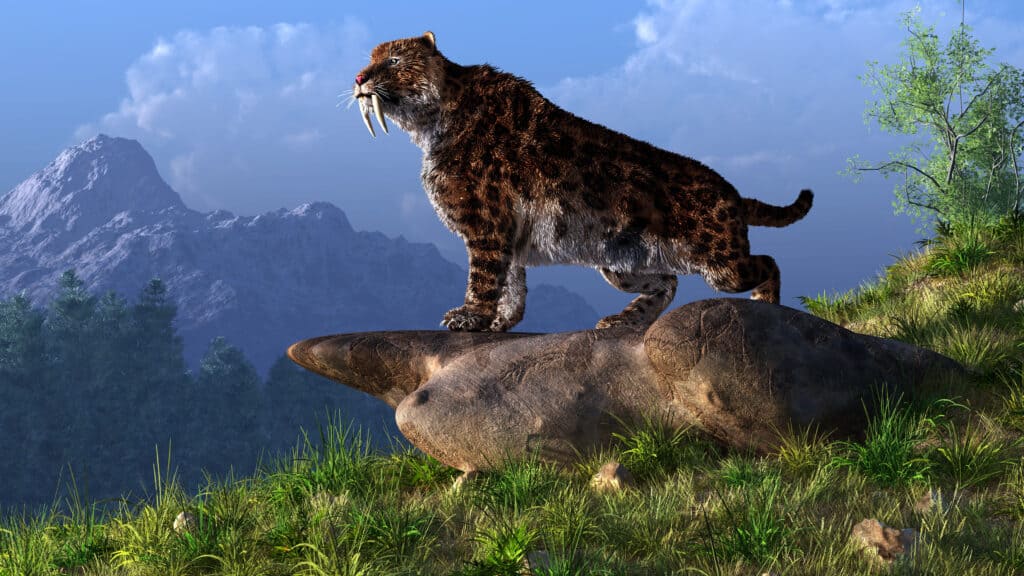
Humans were most likely the cause for the saber-toothed tiger’s demise.
©Daniel Eskridge/Shutterstock.com
It is not known exactly how many saber-toothed tigers existed. Certainly from the thousands found at the La Brea Tar Pits, there must have been many thousands, maybe millions. Their fossils have been found all over North America and South America. This indicates a vast animal population that spread out over a large territory over many thousands of years.
It is sad to think that humans were partly or primarily responsible for the elimination of this creature. However, it was a natural enemy of humans who had to defend themselves, or else they could become the saber-toothed tiger’s next meal.
Saber-Toothed Tiger in the Zoo
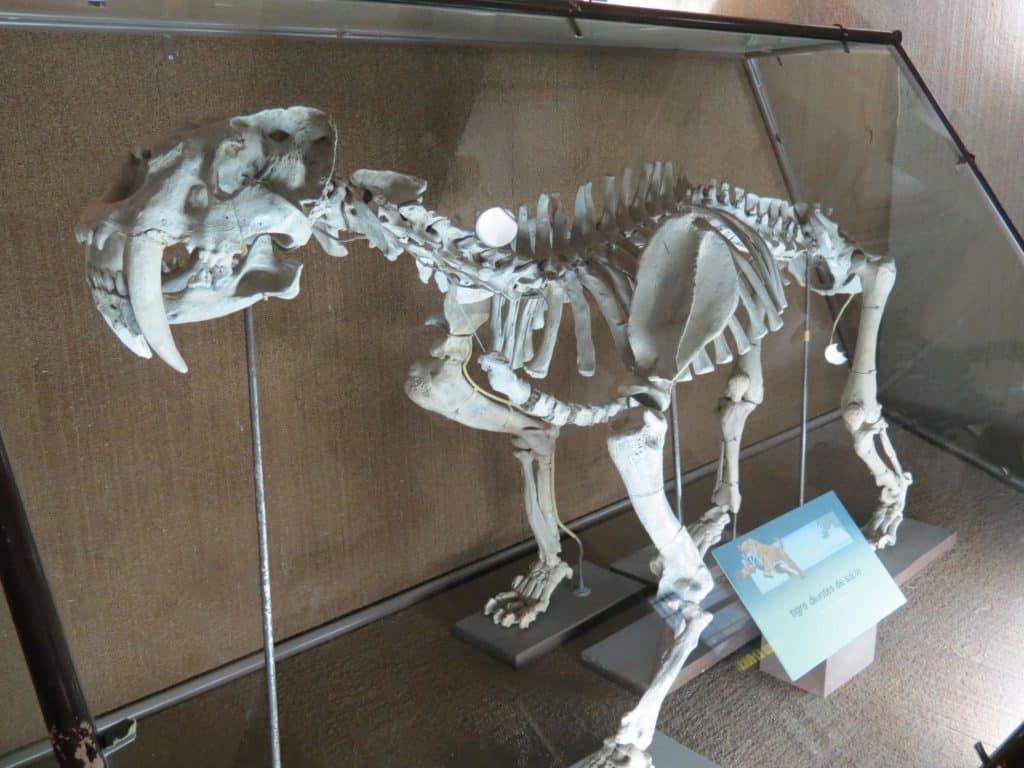
Saber-toothed tiger fossils can be seen in many natural history museums.
The saber-toothed tiger is an extinct mammal so it cannot be found in any modern zoo. However, there is a full scale, realistically-looking, animatronics (robotic) puppet that is a saber-toothed tiger in a show called Ice Age Encounters at the La Brea Tar Pits Museum. [Before going, be sure to check first to see if the museum is open, as it closed temporarily due to the pandemic.]
View all 293 animals that start with SSaber-Toothed Tiger FAQs (Frequently Asked Questions)
How did the saber-toothed tiger become extinct?
Research conducted by the Australian Centre for Ancient DNA concluded that the extinction of the saber-toothed tiger was likely caused by the warming climate at the end of the Ice Age and being hunted by humans. That is the most popular theory but nobody knows for sure.
Previously, it was incorrectly assumed that the saber-toothed tiger became extinct because the food supply ran out. However, there is no evidence that they were forced to eat more bones, which is what happens if the food is in short supply Eating more bones would show up in the fossil record as patterns on the teeth. But this did not happen. They changed what they ate, by eating smaller animals, but did not run out of food.
What is the scientific name for the saber-toothed tiger?
The scientific name for the saber-toothed tiger is Smilodon. There are three species of saber-toothed tigers, which are S. gracilis, S. fatalis, and S. populator.
Where did saber-toothed tigers live?
The saber-toothed tiger lived in the Americas. The species of S. gracilis and S. fatalis lived mostly in North America. The S. populator species lived in South America.
When did the saber-toothed tiger live?
The temporal range for the saber-toothed tiger is from the Early Pleistocene around 2.5 million years ago to the Early Holocene around 11,700 years ago (2.5 to 0.01 Ma). Related ancestral family members of other saber-tooth cats lived as long as 56 million years ago in the Eocene Epoch.
When did saber-toothed tigers become extinct?
The saber-toothed tiger went extinct around 11,700 years ago. After the end of the Ice Ace, most of the megafauna went extinct, including the saber-toothed tiger. This happened during the Quaternary extinction event. Megafauna is large-sized creatures like woolly mammoths, giant sloths, and saber-toothed tigers. The popular theory is that climate change and human hunting caused their extinction.
Are saber-toothed tigers carnivores, herbivores, or omnivores?
A saber-toothed tiger was a predatory mammal with huge canine teeth that was a carnivore (meat-eater).
What Kingdom do Saber-Toothed Tigers belong to?
Saber-Toothed Tigers belong to the Kingdom Animalia.
What phylum do Saber-Toothed Tigers belong to?
Saber-Toothed Tigers belong to the phylum Chordata.
What class do Saber-Toothed Tigers belong to?
Saber-Toothed Tigers belong to the class Mammalia.
What family do Saber-Toothed Tigers belong to?
Saber-Toothed Tigers belong to the family Felidae.
What order do Saber-Toothed Tigers belong to?
Saber-Toothed Tigers belong to the order Carnivora.
What genus do Saber-Toothed Tigers belong to?
Saber-Toothed Tigers belong to the genus Smilodon.
What type of covering do Saber-Toothed Tigers have?
Saber-Toothed Tigers are covered in Fur.
What was the main prey for Saber-Toothed Tigers?
Saber-Toothed Tigers preyed on deer, bison, and woolly mammoths.
What were some predators of Saber-Toothed Tigers?
Predators of Saber-Toothed Tigers included humans.
What were some distinguishing features of Saber-Toothed Tigers?
Saber-Toothed Tigers had large muscular bodies and long canine teeth.
How many babies did Saber-Toothed Tigers have?
The average number of babies a Saber-Toothed Tiger had is 3.
What is an interesting fact about Saber-Toothed Tigers?
Saber-Toothed Tigers had canines up to 7 inches long!
What was the lifespan of a Saber-Toothed Tiger?
Saber-Toothed Tigers lived for 20 to 40 years.
Thank you for reading! Have some feedback for us? Contact the AZ Animals editorial team.
Sources
- Live Science, Available here: https://www.livescience.com/25848-starvation-extinction-sabertooth-cats.html
- Britannica, Available here: https://www.britannica.com/animal/saber-toothed-cat
- Berkeley, Available here: https://ucmp.berkeley.edu/mammal/carnivora/sabretooth.html
- National Geographic, Available here: https://www.nationalgeographic.org/media/sabertooth/
- San Diego Zoo Global Library, Available here: https://ielc.libguides.com/sdzg/factsheets/extinctsaber-toothedcat/characteristics
- Kidzfeed, Available here: https://kidzfeed.com/saber-tooth-cat-facts/
- Wikipedia, Available here: https://en.wikipedia.org/wiki/Smilodon
- La Brea Tar Pits & Museum, Available here: https://tarpits.org/tar-pits-programs/ice-age-encounters

